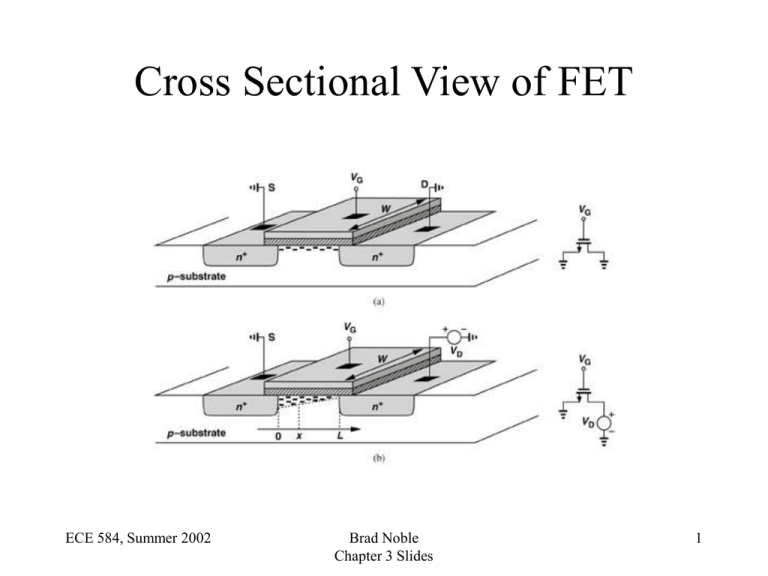ece584ch2
advertisement

Cross Sectional View of FET ECE 584, Summer 2002 Brad Noble Chapter 3 Slides 1 FET I-V Characteristic ECE 584, Summer 2002 Brad Noble Chapter 3 Slides 2 Saturation Voltage • Vpinchoff = VDS,sat = VGS – VTH – Separates resistive from saturation region • The drain current is given by I DS 1 2 N V GS V TN , for NFET 2 V TN V TH and N W • Solving for VDS,sat: L n C ox SK PN V DS , sat V GS V TN ECE 584, Summer 2002 Brad Noble Chapter 3 Slides 2 I DS N 3 Early Voltage Function of Length ECE 584, Summer 2002 Brad Noble Chapter 3 Slides 4 Early Voltage in MOSFETs • Due to channel length modulation: • Good to solve for quiescent voltage-current. I DS 1 V TH L 1 K PN S V GS V TH K PN S V GS V TH 1 2 ECE 584, Summer 2002 V GS 2 2 I DS n C ox W Brad Noble Chapter 3 Slides 2 2 1 V DS 2 L 1 L V DS 1 VE 5 Ex: Find VDS,sat for an NFET ECE 584, Summer 2002 Brad Noble Chapter 3 Slides 6 Body Effect ECE 584, Summer 2002 Brad Noble Chapter 3 Slides 7 Variations in VTH Across Channel • We assume VTH is constant across channel THIS IS NOT TRUE! • Depletion region is thick at S and thin at D. V TH ms Q dep 2 F C ox I DS N V GS 2n n subthresho V TN 2 Cox Gate oxide capacitance inversion layer Cdep ld slope factor 1 Depletion cap, function of x C dep 1 .5 C ox ECE 584, Summer 2002 Brad Noble Chapter 3 Slides 8 Small Signal Equivalent Ckt ECE 584, Summer 2002 Brad Noble Chapter 3 Slides 9 Parasitic Capacitance ECE 584, Summer 2002 Brad Noble Chapter 3 Slides 10 Capacitance Equivalent Circuit ECE 584, Summer 2002 Brad Noble Chapter 3 Slides 11 Variation in Capacitance ECE 584, Summer 2002 Brad Noble Chapter 3 Slides 12 Notes on PFETs • PFETs typically have a shape factor 3 or 4 times larger than NFETs • Body effect can be eliminated in PFETs by tying the n-well to VDD – Need 6m spacing between n-wells to isolate. – Dr. Engel always does this on input devices, not always elsewhere. ECE 584, Summer 2002 Brad Noble Chapter 3 Slides 13 Subthreshold Conduction ECE 584, Summer 2002 Brad Noble Chapter 3 Slides 14 Weak Inversion • What really happens if VGS < VTN? V GS 0 .95 V V TH 1V • In digital design, IDS = 0. • We call it “weak inversion” or W.I. • IDS is primarily due to Idrift in strong inversion and Idiffusion in weak inversion. ECE 584, Summer 2002 Brad Noble Chapter 3 Slides 15 Modes of Inversion • IDS = Idrift + Idiffusion • If VGS > VTN the channel has been inverted. • To be more precise, we can say the channel has been “strongly inverted” (S.I.) due to an abundance of carriers in the channel. • Inversion is independent of whether the FET is in the linear or saturation region. ECE 584, Summer 2002 Brad Noble Chapter 3 Slides 16 Weak Inversion Idiffusion • Drain is more reverse biased than source: N S N 0 exp O q V G V S kT N D N 0 exp O q V G V S kT • To find Idiff, compute gradient dN dx • Because no carriers are lost as they travel from S to D, current is the same for all x and gradient is not a function of x. • Note: This is not really true due to recombination, but its close! ECE 584, Summer 2002 Brad Noble Chapter 3 Slides 17 W.I. Surface Potential 1 VG C ox S s surface potential Cd C ox C d C ox n 1 Cd C ox I DS vG SI D 0 exp nU T Exponentia ECE 584, Summer 2002 -vS exp UT 1 .5, j C d 1 j C d 1 j C ox subthresho ld slope factor - v DS 1 exp UT l law device Brad Noble Chapter 3 Slides 18 Deriving Weak Inversion IDS dN ND NS dx L vG -vS -vD N0 N S exp exp exp L UT UT UT The current per unit width I DS W qD n dN dx : , where D n is diffusion kT , a.k.a. the Einstein D n n q I DS coeff. relationsh ip vG -vS -vD W exp I D 0 exp exp nU T UT UT L ECE 584, Summer 2002 Brad Noble Chapter 3 Slides 19 W.I. FET As Exp. Law Dev. • S must be big for device to be useful. - v DS • If VDS = 100mV, exp can be neglected. UT I DS vG SI D 0 exp nU T -vS exp UT • For W.I. vDS,Sat 100mV i • Looks like a BJT , for V DS 100 mV C v BE ECE 584, Summer 2002 Brad Noble Chapter 3 Slides IC v BE I S exp UT 20 Inversion Coefficient • Let inversion coefficien t i DS o 2nU 2 T Weakly Inverted (W.I.) < 0.1 Strongly Inverted (S.I.) > 10 0.1 < < 10 Moderately Inverted (M.I.) • Shape factor as a function of : S i DS o 2 n K PN U T 2 Lets you chose shape to match inversion mode. ECE 584, Summer 2002 Brad Noble Chapter 3 Slides 21 Ex. Using Inversion Coeff. i DS 1uA, S 100 , 1uA O 2(1.5)(100 )(26mV) 2 (100) 0 . 049 W.I. i DS 100 uA, S 100 , 100uA O 2 2(1.5)(100 )(26mV) (100) 4 . 9 M.I. i DS 1mA, S 100 , 1mA O 2(1.5)(100 )(26mV) 2 (100) 49 S.I. ECE 584, Summer 2002 Brad Noble Chapter 3 Slides 22 Small Signal Analysis Total Voltage Small Change DC Bias v GS v gs V GS Quiescent Voltage v GS V GS O v GS O ECE 584, Summer 2002 v BS Brad Noble Chapter 3 Slides O v DS O i DS O 23 Ex: Quiescent Point V T 0 0 . 75 V v GS 3 V V E 81 V K PN 50 A v DS 5 V 0 . 59 S i DS O i DS O O O V 2 v BS 0 V v DS O O 100 μ m v GS O v BS O i DS O 10 μ m O K PN S v GS v T0 2 1 1 100 m 2 10 m 2 2 F v SB O v DS 2 F 1 VE O A 5 2 50 2 3 0 . 75 1 1 . 34375 mA V 81 Question: How many digits are significant? ECE 584, Summer 2002 Brad Noble Chapter 3 Slides 24 Small Signal Model Limits • Suppose the previous circuit is the input device of an amplifier. • Small-signal model holds as long as the deviations are small kT q ECE 584, Summer 2002 Brad Noble Chapter 3 Slides 25 Taylor Series Expansion • Taking a Taylor expansion of one variable: f ( x ) f ( x 0 ) f ( x )( x x 0 ) 1 2 2 f ( x )( x x 0 ) Linear Approx. 0 i DS i 0 DS 0 0 i DS i DS i SB v GS v DS v SB v GS v DS v SB gm v GS v GS - v GS v gs O g ds v DS v ds g mb v SB v sb i DS iDS iDS O ECE 584, Summer 2002 Brad Noble Chapter 3 Slides 26 Small Signal Model Params 0 i DS gm v GS 0 g ds v DS O 2 1 i DS , for large V E , g m VE O 2 i DS O i DS 1 i DS VE r ds v DS O 0 g mb i SB , typically g m where O 2 2 F v SB v SB Gain g m r ds ECE 584, Summer 2002 Brad Noble Chapter 3 Slides 27 1 Example: Small Signal Analysis i DS 1 . 34375 mA, V E 81 V, 250 O μA V 2 Let v GS 3 . 026 V (up by kT q ) , v BS 0 V, v DS 5 . 026 V Using full equation (lots of work! ) : iDS 1 . 3754 mA iDS 31 . 65 μA Using small signal analysis iDS g m v gs g ds v ds (1 . 1592 ECE 584, Summer 2002 mS : 2 i DS O i DS v gs v ds VE )( 26 mV ) ( 0 . 0166 Brad Noble Chapter 3 Slides O mS )( 26 mV ) 30 . 57 μA 28 Small Signal Low-Freq Model i ds S.I. signals Sat gm v gs small 2 i DS g m v gs g mb v ds rds O , where n subthresho ld slope factor 1.5 n r ds VE O V E L i ds ECE 584, Summer 2002 O i ds Brad Noble Chapter 3 Slides 29 Ex: Find gm and rO i DS 10 μA O W L Is it S.I. and saturated? 10 μm If so, 2 4 10 100 μA/V gm 4 μm 2 10 uA 23 μS 1 .5 r ds V EN L i ECE 584, Summer 2002 O DS 10 V μm 10 μm 10 μA Brad Noble Chapter 3 Slides 10 M 30 Transconductance: W.I. & M.I. • What is gm for a weakly inverted FET? 0 i DS i DS gm nU T v GS O Not in textbooks! • What is gm for a moderately inverted FET? 0 i DS 1 exp i DS gm , where nU T v GS ECE 584, Summer 2002 g ds O i DS O for all modes VE Brad Noble Chapter 3 Slides 31






